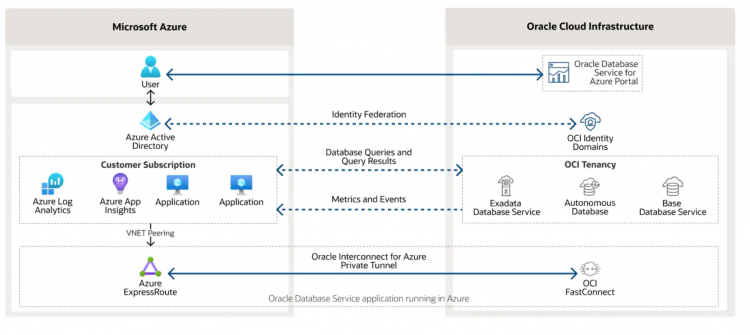Oracle and Microsoft have jointly announced that Oracle Database Service for Microsoft Azure is generally available as of July 20, allowing organizations that built their services on Azure and Oracle products to seamlessly connect components when running them on separate clouds.
The Oracle Database Service for Azure builds on the capabilities of the Oracle Interconnect for Azure. The portal establishes low-latency connectivity, virtual networks, and federated identity management between Azure and Oracle Cloud Infrastructure (OCI). Databases are connected via the Interconnect, while database logs and metrics from OCI are fed into Azure to simplify management. Customers will be billed for the consumption of Oracle Database services as usual and not for the Oracle interconnect for Microsoft Azure ports.
How the two clouds communicate with each other at different layers. Source: Oracle
On its product page, Oracle described a couple of scenarios the new service is suited for. Users of on-premises workloads migrated to multi-cloud environments built on Azure and OCI can choose to run their applications and databases in their preferred cloud without having to worry about taking a performance penalty. The service’s private tunnel, enabled by Oracle Interconnect for Azure, establishes a private low-latency connection between the two cloud environments.
 Developers split-stacking their services when moving to a fully-managed architecture will experience no performance penalties thanks to the interconnection between the two clouds. Source: Oracle
Developers split-stacking their services when moving to a fully-managed architecture will experience no performance penalties thanks to the interconnection between the two clouds. Source: Oracle
Oracle Database Service for Azure is also useful for split-stack Azure and OCI deployments where developers are looking to move from self-managing to fully-managing services for their workloads. Customers can leverage exclusive benefits that are available when running their database on the Oracle Cloud Infrastructure, such as Oracle Maximum Availability architecture. With the Oracle Database Service for Azure, applications can continue to run in Azure while the databases are migrated to OCI, combining the best of both worlds.
In North America, the service is available in the following zones.
OCI location
Azure location
OCI Canada Southeast (Toronto)
Azure Canada Central
OCI US East (Ashburn)
Azure Washington DC and Washington DC2
OCI US West (Phoenix)
Azure Phoenix
OCI US West (San Jose)
Azure Silicon Valley
Source by www.itworldcanada.com






























